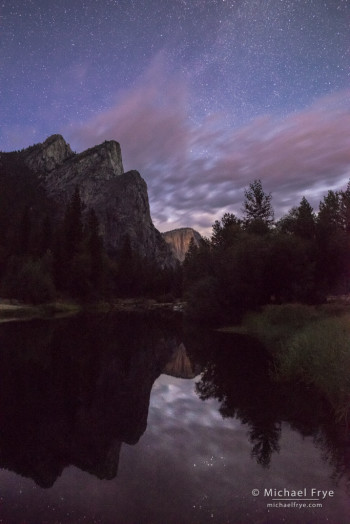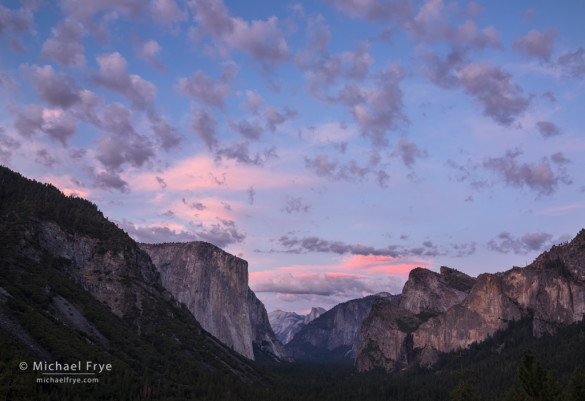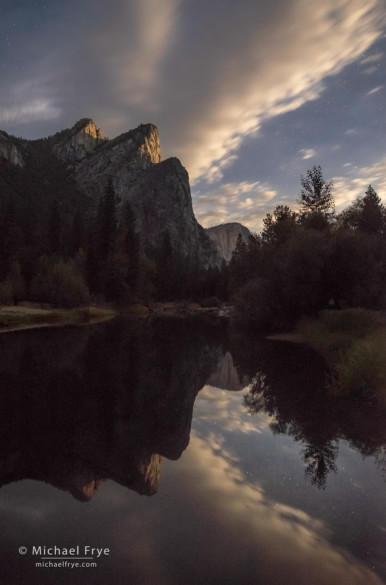Tuesday evening Claudia and I drove to Yosemite Valley. The moon was due to rise about 90 minutes after sunset, so I hoped to photograph the northern end of the Milky Way over Three Brothers, with the rising moon adding a bit of light to the peaks.
We got to the Valley well before sunset, but there were some interesting clouds, so we decided to head to Tunnel View, where we found the usual August assortment of tour buses and people taking selfies in front of the panorama. I photographed some interesting patterns of dappled sunlight and clouds, then, just at sunset, after the crowds had thinned, the sky turned pink and a beautiful array of tufted clouds drifted overhead (below).
We had a little picnic along the Merced River as we waited for the sky to get dark, then I started taking photos of Three Brothers. At first the clouds blocked most of the stars. But the sky gradually cleared, revealing more stars, and then, looking at the photos on my camera’s LCD screen, I could see the clouds taking on a pink hue, and a hint of light on Yosemite Point in the distance. This was the lunar equivalent of a predawn glow, with the moon still below the horizon, but already adding some light and color to the scene. My eyes couldn’t see the color, but the camera could (right).
Later, as the moon rose for real, the clouds and peaks turned gold, just as they would at sunrise. Again, it was too dark for the cones in my retinas to pick up the color, but the camera recorded it perfectly. And some of the cloud formations were spectacular, fanning out in big V shapes above Three Brothers (below).
Normally you want clear skies for star photographs. But moonlight can make nighttime clouds spectacular. And low-angle moonlight is like low-angle sunlight, creating gold, orange, and pink hues just like you see at sunrise and sunset. (I used this same idea – low-angle moonlight – to photograph Horsetail Fall a few years ago.) While the quantity of light from the moon is low, the quality of light is essentially the same as sunlight. With enough exposure, a moonlit scene can look just like a daytime scene – only with stars in the sky.
— Michael Frye
Related Posts: Horsetail Fall by Moonlight; Under the Full Moon; Moonstruck
Did you like this article? Click here to subscribe to this blog and get every new post delivered right to your inbox!
Michael Frye is a professional photographer specializing in landscapes and nature. He is the author or principal photographer of The Photographer’s Guide to Yosemite, Yosemite Meditations, Yosemite Meditations for Women, and Digital Landscape Photography: In the Footsteps of Ansel Adams and the Great Masters. He has also written three eBooks: Light & Land: Landscapes in the Digital Darkroom, Exposure for Outdoor Photography, and Landscapes in Lightroom 5: The Essential Step-by-Step Guide. Michael written numerous magazine articles on the art and technique of photography, and his images have been published in over thirty countries around the world. Michael has lived either in or near Yosemite National Park since 1983, currently residing just outside the park in Mariposa, California.












Awesome star photo over three brothers….how did you come to determine the ISO of 6400? I noticed that both “brother” photos were shot at ISO 6400. Thanks for continuing to inspire me!
Thanks Mary! I used 6400 ISO because I knew from experience that would work. If you want pinpoint stars, the constraint is star movement, which means that you can’t have too fast a shutter speed or the stars will streak. In this case, with a 24mm lens, 20 seconds was the longest shutter speed I could use without getting streaks. So given that, the wider the aperture, and the higher the ISO, the more stars you’ll see in the photo. Even though I was using an f/1.4 lens, I didn’t want to use it at anything wider than f/2.8, because I knew it wouldn’t be sharp enough in the corners at f/1.4 or f/2. So that leaves the ISO, and at 20 seconds and f/2.8, 6400 ISO is enough to show the Milky Way and lots of stars.
As the moon rose, that exposure was too much, and I started to see blinkies in some of the clouds. I could have lowered the ISO then, but the clouds were moving quickly, so I decided to shorten the shutter speed to ten seconds instead, which kept the clouds from blurring too much.
Gorgeous light combos and reflections! Amazing to see the stars in almost daylight.
Thank you Andrys!
Beautiful Michael. And proof once again that, chance favors the prepared mind.
Indeed John – thanks!
Wonderful shots. I keep going back and forth between the Three Brothers shots trying to decide which I like better. I guess that’s a good sign. Even when night shots are exposed and processed similar to a daytime shot (kind of like the last one), they convey a mood that is different than daytime – even if I can’t really figure out why. Thanks for writing about these!
Thanks very much Kyle. The last one does look rather like a daytime image, though I would have lightened the shadows much more on a daytime image like this.
Absolutely beautiful! The Tunnel View shot is especially gorgeous — the pink hues in the sky are magnificent. And the clouds . . . personally, I love landscapes with interesting clouds — doesn’t take away anything for me, and I love another element to enjoy in a photo.
Thanks very much Meg! Clouds always add something to landscape images. Well, almost always.
Working at night and at dusk, I assume you use some brand of insect repellant. Do you have any plastic equipment disasters with insect repellant on your hands you can warn us about? Or do you have a hand cleaner routine that works well? Thanks
PS. How do you avoid stepping on snakes?
Bill, I’m pretty tolerant of mosquitos, and avoid using repellent as much as possible. When the mosquitos get really bad, I use a spray, so I don’t get it on my hands. This late in the summer, there were no mosquitos along the river when I made the Three Brothers images. As for snakes, they’re not a problem in most areas I go. I’ve seen maybe three rattlesnakes in 30 years in Yosemite, and always in rocky areas, not in meadows or along the river.
Another wonder from Michael, the the Horse Tail Fall by the moonlight ! Thanks for sharing with setting information and tip.
Thanks Hung!